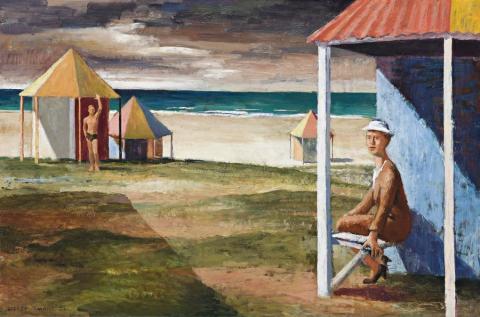TAMARAMA, 1954
JEFFREY SMART
oil on composition board
61.0 x 91.5 cm
signed and dated lower left: JEFFREY SMART 54
Artlovers Gallery, Artarmon, December 1963
Geoff K. Gray Pty Ltd, Sydney, 29 August 1968, lot 122 (as G. Smart, 'Beach Houses')
Private collection, Sydney
New South Wales Contemporary Art Society, September 1954
Crouch Prize Competition, Ballarat Fine Art Gallery, 1955
Jeffrey Smart, Macquarie Galleries, Sydney, 29 August – September 5, 1955, cat. 2
Jubilee Art Exhibition, The Council of the Municipality of Ku-ring-gai, Killara Memorial Hall, Sydney, 15–23 June, 1956, cat. 38
Gleeson, J., 'Artist implies his drama', The Sun, 24 August 1955
Quartermaine, P., Jeffrey Smart, Gryphon Books Pty Ltd, Melbourne, 1983, p. 105, no. 276
When Jeffrey Smart returned to Australia in 1951 after three years in Europe, he chose to settle in Sydney rather than his hometown of Adelaide. He had exhausted his financial resources abroad and sought ways to sustain his life as an artist. He wrote art criticism for the Daily Telegraph and began his long and highly successful association with the ABC, first on the children's radio program The Argonauts and later on television in the Children's Hour.'In Sydney, before my mother remarried, I was very poor and had no motor car. I think I was in Somerset flats. I had an idea for a painting at Tamarama.'1 What makes the painting stand out in Smart's work of the time is the fact that it was painted plein air, rather than constructed in the studio as the result of careful planning. How it came about was made clear in a recent interview:' It was at the very long end of the bus line, so I had to go out with all my gear and a large canvas to the terminus at Tamarama. All went well, and when I finished I had to wait half an hour for the next bus. There were some shops there and I looked at a second hand shop. In the window were lots of tatty little vases etc., including an oil sketch by, I think it was, Harold Gilman RA. Not a bad little thing, so I thought I could make a few bob by buying it. But when I asked the owner of the shop, a large European who spoke little English, I would buy it for a few quid, he informed me it was by Harold Gilman RA and the price was £80, which was about right. So we struck up a conversation. He asked me my name and when I told him, he said, 'I vill sell your verk von day' His name was Rudy Komon.'2
The beach was a natural habitat for Jeffrey Smart. The stark horizon lines, and the clear stretches of sand and sea were the ideal backdrop for his subtle plays of human drama, as well as a safe and logical place to depict near naked figures in action. The beach in Tamarama provides a fascinating interplay between three people " two visible, the invisible third being the artist himself. Both figures are reacting to the presence of the artist, who we can guess has called out to announce his arrival. An elegantly posed young man in swimming trunks raises his arm in recognition, while the formally clad woman to the right turns to gaze at the newcomer. The handsome boy is at home beside the small pavilion, but why is the woman there at all, decked out in her Sunday hat, neat brown suit and best high heels? Is she, too, waiting for a lover, disappointed that the new arrival obviously has eyes for someone else?
A lowering, dark sky, a favoured Smart device, and the clear light and hard shadows of the afternoon sun heighten the drama of the scene. In many aspects it is a precursor to Smart's mature style, which developed on his return to Italy. The use of simple geometric structures adding balance and contrast to the landscape, the dramatic use of light and the precision of his drawing all became the hallmarks of his work. The painting represents a crucial moment in the development of Jeffrey Smart as an artist and was exhibited at Macquarie Galleries in 1955 in the artist's first one-man Sydney exhibition.
1. Smart, J., Correspondence to Stephen Rogers, 6 July 2011
2. Ibid.
GAVIN FRY
